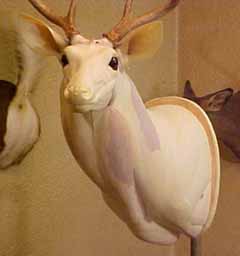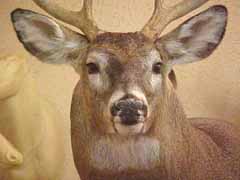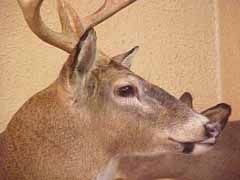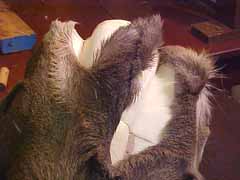June 4, 2003
The deer in the following photos pushed the limitations of STOP-ROT about as close as I care to take it. The sad thing is, taxidermists across the country see this same scene played over and over again each year.
The procedures I describe here would not be practical for most commercial applications. But unless some one goes first to gather the initial data, there isn't any facts to build on to turn procedures into practical application. With what I saw and experienced with this cape, I think I am seeing the possibility of more STOP-ROT application usage starting to open up. By the time I was finished with this one, I had tripled the amount of STOP-ROT normally needed, and that really extended the work time.
This buck had been taken on a Saturday morning. The hunter had called me later that day and set it up to bring me the cape the following day. He didn't show up...............until the following Friday evening.
The guy had been deer hunting for five years and finally tagged his first buck, a hefty 197 lbs. field dressed with an 8" nose to eye, and 23" behind the ears. His thinking was to turn the care of his trophy over to the professionals for fear of screwing something up himself. The butcher shop had assured him they could handle the skinning and caping for him.
I could smell this cape before I got around to the back of the guy's truck.
It was green, slimy and dripping. The cape had been cut up each side of the brisket, and one leg had been cut off at the union of the fore arm and upper arm, but the skin was still hanging off of the brisket. The head was never skinned out and blood had back flushed into the skin, the "see the red through the parted hair" variety. It also had drag or rub marks on each shoulder.
I tried to refuse the job, but the man was genuinely disappointed and upset. I said, "O.K., I've got some stuff that might save it."
I promptly applied STOP-ROT to the exposed flesh side of the cape, and to the hair side of the ears, nose, lips and eyes and then skinned out the head applying the STOP-ROT as I skinned. I rolled it up and put it in the freezer.
I did a little form alteration to get the proportions, fit and "look" I was looking for. I reworked the head, neck, shoulders and brisket. You can see the untrimmed back board in the photo. I wanted to be able to do a test fit with the green hide, no pun intended, before proceeding.
The cape spent six months in the freezer. As it thawed and unrolled, I kept applying STOP-ROT to the flesh side. I fleshed it out on the fleshing machine, applied another coat of STOP-ROT and shaved it thinner yet. The dead, rotten odor was only about 50 % gone, and the blood was not floating up out of the skin like it does with STOP-ROT on a fresher cape.
I took advantage of the work time the STOP-ROT was giving me and did almost all of the scalpel work around the eyes, lips and nose. The eye skin on both eyes had already shown a couple of little slip spots, and the right eye lid was moosh, so I figured the epidermis would slip off some where along the line. Didn't happen. In the photo of the unfinished eye, you can see the slipping went no further.
By the time I got through playing around, the cape was starting to some what air dry in places, and I DID NOT want to salt it in that state.
I put five gallons of plain old water in a plastic tote and added enough Leatherizing Acid to drop the pH to a high 5. I then put the cape in that solution. That REALLY blew a lot of nasties out of the skin and hair. I left the cape in until it was soft and then rinsed with running water. I salted the cape down and rolled it up.
Six hours later the cape was already starting to get stiff from salt drying. I'm darn glad I checked it, I had mental images of a dried out coil of a cape that might have been hard to rehydrate. I once again rehydrated with plain old water until soft, and then put it into the Leatherizing Acid pickle, just eight hours after salting. At that point, the rotten dead odor was ALMOST gone, but the skin still had a green cast.
The skin had plumped the next day. The green cast was gone, but it was just a trade off for a purplish cast, which told me that progress was heading in the right direction. I pulled the cape out of the pickle and let it hang with the flesh side exposed to the air for a few hours.
Allowing some drying like that is not normally a good practice. But I knew if I did that I would be able to cause oxidation, or bleaching, of the remaining blood once the cape was put back into the pickle. This trick also finished eliminating the ODOR. The down side of that is, the skin fibers will bond a lot of acid, which is why a pickle pH may shoot way up after the skin is shaved and returned to the pickle. If a lot of acid is in the skin, buffering and relaxing the skin can be a real trick.
Every thing went as expected. I put the cape back in the pickle, pH shoots up, add more acid, skin is now holding acid, BUT the leather did turn white.
The cape appeared ready to finish out in the first 48 hours, but I decided to leave it in the pickle for another day just to see if it would make any difference in appearance. In hind sight, I may have been better off to have finished it after the two day mark. During this time, the pickle was at 70 degrees F. or lower, and room temperatures in the same ball park.
EYE LIDS, ORBITAL SOCKET AREA AND BROW MUSCLES
On this particular cape, I had removed ALL the muscle meat from those areas, plus split the eye lids prior to salting.
Past experiences has shown me that those small muscles will hold acid even after buffering and will prevent the under lying skin from buffering. The epidermis of the eyes will in turn frequently slip at the time of buffering, or at the "drying down point" when attempting to position and tuck the eyes.
Where I had split the lids before pickling, they had puffed up considerably in the pickle, which they would have done any ways, but it was just more obvious.
To draw the acid, I put a couple of spoonfuls of table salt on the flesh side of each eye and gave the lids enough time to collapse before placing the cape in a baking soda buffer solution. I can not really say as to how much this contributed to lack of additional slip of the epidermis, but I do know that by doing something as simple as this, I have not had epidermal slip with other capes.
I rinsed the hair side and flesh side with running water before placing in the buffering solution.
The buffering and FAT-B-GONE process went pretty well normal. At this point, the cape was pretty wet and I did not know as to how "fragile" the cape was, and I did not want to push my luck in ridding the excess moisture. So I just used a plastic tote and made a bed with clean ground corn cob, put the cape on it, covered with more cob, and allowed the cob to draw the moisture. I did this to both the flesh and hair sides.
The SHRINK TONIC application produced a lot more water as a result of chemical reactions than normal. I usually just give this step an hour to finish reactions, but in this case, I just left for four hours, and it was wet enough that I once again put it through corn cob absorption.
Finishing with CAM-L-C again produced excesss moisture. Most of the time, I just freeze capes at this point for later mounting, but again, I did not know how much I could push my luck.
I hung the cape over a fleshing beam for a day and a half, periodically turning it in and out to allow air drying. Once it was starting to dry down, I rolled it up and sweated it in cotton for several hours and then mounted.
I used the new Epo-Grip water base hide adhesive for the first time on this mount. I really like the way that stuff works. I used NO pins, I hate pins. The work time it gave me fit my work style. I did not get any gas formed odors from reactions with it either.
The eyes are Van Dyke's Natural Eyes in the medium color. The nictating membrane is the new one by Brad Eppley. Ears are Mc Kenzie's Natra Look medium.
The photos below were taken right after mounting and after the mount had dried. Finishing of the nose and eyes has not been done.
You can see in the pictures that show the front on view of the ears where there is a hair slip spot on the upper side of the left ear. The inside of the lower part of the ear was rotted bad, and frankly, I never thought to get some STOP-ROT down in there at the time I first handled the cape.
The hair around the drag mark areas of the shoulder could be pulled out in some places until the mount was dry. The epidermis slipped in front of the entry and exit wound behind and below the shoulder blade. Both slip spots were almost as big as a fifty cent piece. That's about the extent of the damages.
Later.
Glen
© WHITETAIL DESIGNER SYSTEMS, INC. TM 2001
To Order: Telephone Toll Free in U.S.A. 1-866-849-9198 or 1-877-861-5679
Question? Need assistance? Phone 1-765-966-4651
FAX: 1-765-966-9866
STOP-ROT
The WHITETAIL DESIGNER SYSTEMS product that is changing the way taxidermy gets done! EVERY taxidermist can use this!
If you are not already using it, the photos and text will help to get you acquainted with STOP-ROT, BUT it is really something you need to experience for yourself!

Continued from previous page.
More STOP-ROT tanning and taxidermy applications are on Hide Tanning and Taxidermy www.hidetanning.net. These articles include:
STOP-ROT in mammal skin tanning
STOP-ROT in Wild Turkey Taxidermy
STOP-ROT in Fish Taxidermy
STOP-ROT on freezer burn
STOP-ROT as a preparation for taxidermy tanning
STOP-ROT and long term freezing of capes
STOP-ROT as a preservative
STOP-ROT is available from the following
taxidermy supply companies. High lighted
suppliers can be ordered from on-line.
RESEARCH MANNIKINS 1-800-826-0654
AEWS Taxidermy Supply 1-800-529-3470
WASCO 1-800-334-8012
Keystone Fur Dressing 1-717-677-4553
Quality Taxidermy Supply 1-888-527-8722
Van Dyke's Taxidermy Supply 1-800-843-3320
WHITETAIL DESIGNER SYSTEMS
1-866-849-9198 or 1-877-861-5679


